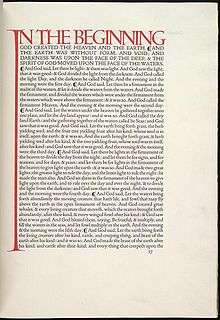Doves Press

The Doves Press was a private press based in Hammersmith, London. It was founded by T. J. Cobden-Sanderson before 1900 when he asked Emery Walker to join him. The business was financed by Anne Cobden-Sanderson. Their partnership was dissolved in 1908[1] but Cobden-Sanderson continued to print.
Cobden-Sanderson commissioned the press's type, which was drawn under Walker's supervision, and the Doves Bindery which he had set up in 1893 bound the books he and Walker printed. The Press produced all its books using a single size of this type, between 1900 and 1916, and is considered to have been a significant contributor to the Arts and Crafts movement. The founders were associated with William Morris and the Kelmscott Press. The type, known as 'The Doves Type', was based on types used by Nicolas Jenson from the 1470s, similar to Morris's earlier Golden Type, and cut by Edward Prince.[2][3][4][5]
The press, at No. 1, Hammersmith Terrace, was named after The Dove, an old riverside pub nearby. The Doves Press was responsible for the Doves Bible (5 vols, 1902–1904), which is considered to be one of the best examples of its kind.[3]
By 1909 Cobden-Sanderson and Walker were in a protracted and bitter dispute involving the rights to the Doves Type in the dissolution of their partnership. As part of the partnership dissolution agreement, all rights to the Doves Type were to pass to Walker upon the death of Cobden-Sanderson. Instead of letting this happen, the matrices were destroyed by Cobden-Sanderson on Good Friday, 21 March 1913 by casting them into the Thames off Hammersmith Bridge in London, a short walk from the Press. As further recorded in his Journals, he began the destruction of the types beginning 31 August 1916 at midnight, when "it seemed a suitable night, and time".[6] He is said to have completed the task in January 1917, after 170 trips to the river,[7] though his Journals do not mention the culmination.
The Doves Type revival
After the destruction of the matrices and type by Cobden-Sanderson, the Jensonian type design used by the Doves Press was recently re-created as a digital facsimile by Robert Green.[8] In 2015, after searching the riverbed of the Thames near Hammersmith Bridge with help from the Port of London Authority, Green managed to recover 150 pieces of the original type.[9][10]
Notes
- ↑ The London Gazette: no. 28274. p. 5759. 27 July 1909. Retrieved 8 February 2015.
- ↑ Naylor, Gillian: "The things that might be: British design after Morris". In Diane Waggoner, ed.: The beauty of life: William Morris & the art of design. New York: Thames and Hudson, 2003, ISBN 0-500-28434-2, p. 122-124
- 1 2 The Columbia Encyclopedia, Sixth Edition. 2001-05.
- ↑ Dreyfus, John (1974). "New Light on the Design of Types for the Kelmscott and Doves Presses". The Library. s5-XXIX (1): 36–41. doi:10.1093/library/s5-XXIX.1.36.
- ↑ Tuohy, Stephen (1990). "A New Photograph of Edward Prince, Typefounders' Punchcutter". Matrix. 10: 135–142.
- ↑ The Journals of Thomas James Cobden-Sanderson | 1879–1922 | Volume II — p. 296
- ↑ "The fight over the Doves". The Economist. 21 December 2013. Retrieved 7 February 2015.
- ↑ Doves type at typesec
- ↑ Steven, Rachael (3 February 2015). "Recovering the Doves Type". CreativeReview Blog. Retrieved 7 February 2015.
- ↑ Wilmshurst, Nick (7 February 2015). "Lost typeface printing blocks found in river Thames". BBC News. Retrieved 7 February 2015.
References
- Marianne Tidcombe. The Doves Press. London: British Library; New Castle, Delaware: Oak Knoll Press, 2002 [i.e. 2003].